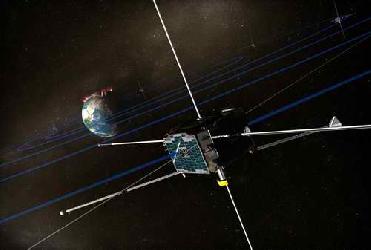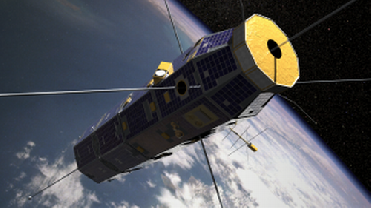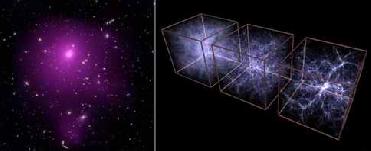
One of the THEMIS probes exploring the space around Earth, an artist's concept. NASA photo
WASHINGTON (BNS): There is a breach in the Earth�s magnetic field ten times larger than anything previously thought to exist. This has been discovered with the help of NASA�s five THEMIS spacecraft. �Solar wind can flow in through the opening to �load up� the magnetosphere for powerful geo-magnetic storms. But the breach itself is not the biggest surprise. Researchers are even more amazed at the strange and unexpected way it forms, overturning long-held ideas of space physics,� NASA mission managers said.
THEMIS project scientist David Sibeck of the Goddard Space Flight Center, said that at first, he too didn�t believe it. �This finding fundamentally alters our understanding of the solar wind-magnetosphere interaction,� Sibeck said.
NASA said that the magnetosphere is a bubble of magnetism that surrounds Earth and protects us from solar wind. Exploring the bubble is a key goal of the THEMIS mission, launched in February 2007. �The big discovery came on June 3, 2007, when the five probes serendipitously flew through the breach just as it was opening. Onboard sensors recorded a torrent of solar wind particles streaming into the magnetosphere, signaling an event of unexpected size and importance,� NASA said.
Wenhui Li, a space physicist at the University of New Hampshire, who has been analyzing the data, said that the opening was huge - four times wider than the Earth itself. Li's colleague Jimmy Raeder, also of New Hampshire, said that 1027 particles per second were flowing into the magnetosphere - that's a 1 followed by 27 zeros. �This kind of influx is an order of magnitude greater than what we thought was possible,� Raeder said.
Scientists at NASA said that the event began with little warning when a gentle gust of solar wind delivered a bundle of magnetic fields from the Sun to Earth. �Like an octopus wrapping its tentacles around a big clam, solar magnetic fields draped themselves around the magnetosphere and cracked it open. The cracking was accomplished by means of a process called �magnetic reconnection.� High above Earth's poles, solar and terrestrial magnetic fields linked up (reconnected) to form conduits for solar wind. Conduits over the Arctic and Antarctic quickly expanded; within minutes they overlapped over Earth's equator to create the biggest magnetic breach ever recorded by Earth-orbiting spacecraft,� NASA said.
New Hampshire scientist said that the size of the breach took researchers by surprise. �We've seen things like this before, but never on such a large scale. The entire day-side of the magnetosphere was open to the solar wind,� Raeder said.
NASA said that space physicists have long believed that holes in Earth's magnetosphere open only in response to solar magnetic fields that point south. �The great breach of June 2007, however, opened in response to a solar magnetic field that pointed north,� NASA said.
�To the lay person, this may sound like a quibble, but to a space physicist, it is almost seismic. When I tell my colleagues, most react with skepticism, as if I'm trying to convince them that the sun rises in the west,� Sibeck said.
The THEMIS project scientist said that most did not believe it. �The solar wind presses against Earth's magnetosphere almost directly above the equator where the planet's magnetic field points north. Suppose a bundle of solar magnetism comes along, and it points north, too. The two fields should reinforce one another, strengthening Earth's magnetic defences and slamming the door shut on the solar wind. In the language of space physics, a north-pointing solar magnetic field is called a �northern IMF� and it is synonymous with shields up,� Sibeck said.
�So, you can imagine our surprise when a northern IMF came along and shields went down instead. This completely overturns our understanding of things,� Sibeck added.
Northern IMF events don't actually trigger geo-magnetic storms, notes Raeder, but they do set the stage for storms by loading the magnetosphere with plasma. �A loaded magnetosphere is primed for auroras, power outages, and other disturbances that can result when, say, a CME (coronal mass ejection) hits,� Sibeck said.
The years ahead could be especially lively. �We're entering Solar Cycle 24. For reasons not fully understood, CMEs in even-numbered solar cycles (like 24) tend to hit Earth with a leading edge that is magnetised north. Such a CME should open a breach and load the magnetosphere with plasma just before the storm gets underway. It's the perfect sequence for a really big event,� Raeder explains.
On the other hand, Sibeck agreed that this could result in stronger geo-magnetic storms than one has seen in many years.
 Previous Article
Previous Article Next Article
Next Article












The Indian Air Force, in its flight trials evaluation report submitted before the Defence Ministry l..
view articleAn insight into the Medium Multi-Role Combat Aircraft competition...
view articleSky enthusiasts can now spot the International Space Station (ISS) commanded by Indian-American astr..
view article